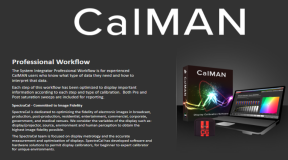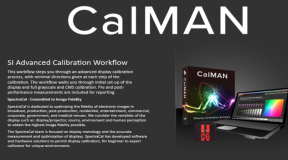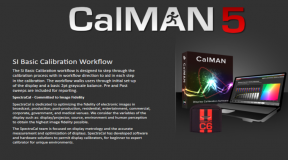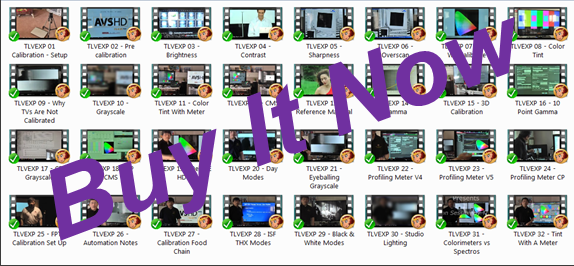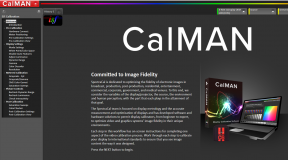The problem with the class is not the material about how to calibrate television displays. It is the complete lack of information on how a calibration business actually works and remains successful. As it turns out, knowing how to calibrate a display is simply not enough to make a successful business. It works in a classroom environment, but not in the real world. The independent calibrators that manage to succeed in this business had to figure out this business model approach by themselves the hard way.
The issues with the ISF Level II class start at their foundation which is not just about teaching people how to calibrate displays. If that is all, then the class does its job correctly, but unfortunately, that is not all. For a class that simply teaches people how to calibrate displays over two days or three days would have a hard time justifying the $1000 to $1800 that is charged for the class. What type of enthusiast would spend that type of money to attend such a class and then be convinced to spend another $10000 for what was only a $5000 TV they had at home? (On the THX end, we’ve had two of exactly this type of person in the four years of the program so they do exist.) So the class has to offer the students something more than just teaching them how to calibrate displays. There has to be a business angle to this so that people can recoup their capital investment in both the class and the equipment there after.
And in creating this business angle, the program has failed in its duties and responsibilities to the students. Yes, this is a lesson in ethics and morality. The question is whether it is ethical to continue this practice of convincing people that they can make easy money in calibration knowing full well that the failure rate in this business is as high as it actually is, although that part of the reality is never presented to the students.
What is the root cause of the business of calibration shortfall?
Well, if we examine who has been responsible for the creation of the ISF Level II class material, the picture becomes more clear. It turns out that an engineer that works for the hardware manufacturer was the primary author of the ISF education program. Joel Silver would teach this material to the students and he does a masterful job at that, teaching and presenting what he has been given. Problem is … the program was created by an engineer that understands the science behind the calibration process, but does not run a business as a calibrator. It is then taught by a person that understands the science of calibration as well, but again does not actually calibrate for real clients. (Joel’s clients all have expensive cars and jets and are not part of the reality of the typical calibrator. ) So neither of the two most involved in the ISF Level II program actually calibrated displays for a living and thus have no experience or understanding of how the business of calibration really worked. They’ve never experienced it so how could they possibly know that many problems can and do exist.
Here we have the scenario of the engineers that understand the design of the fighter planes trying to teach people to be fighter pilots. The THX video program uses seasoned fighter pilots who also understand how the planes work to teach people to be fighter pilots.
The eagerness of the sales staff that finds people to attend the ISF classes also served to hinder the very class they are to serve. Depending on the location of the class, it is very possible to have upwards of 30 or more students in the same class while only having four to five work stations. If one does the math here, that is six people per station versus the two people per display in the THX class. People attending these high volume ISF classes have commented that by the time it is their turn to play with a display for their practical experience, time runs out in the class and students have to return to their seat for more lectures. The promise of more hands on time to come somehow never pans out and some students are left wanting in the same class where others might think they had plenty of hands on time.
So what quality assurance program does the ISF organization have in place to make sure their calibrators have the knowledge to properly calibrate a display? Over on the THX end, each student needs to submit 10 calibration reports to the instructors to demonstrate their competence prior to certification. At the start of the ISF Level II program, the number was four. That number has dropped to just one calibration to demonstrate competence; one versus ten. Is this a joke? What is the big deal about oversight? Well, THX has it and ISF does not. Imagine a scenario where a calibration concept is taught to the student and he misunderstands the application of that concept, but he just doesn’t know that. He is sure he fully understood what was taught. With limited classroom hands on time that never dips into the evenings and no oversight for the quality of his field calibrations, his misunderstanding is never caught and corrected. He continues to commit this error on all the displays that he encounters … and hundreds of displays in experience mean nothing since they were all done incorrectly.
Both the ISF and the THX programs have required that their calibrators possess calibration equipment to do the job. The THX program has looked at the individual equipment choices on the market and determined which devices would be satisfactory for their calibrators and which would not be. THX calibrators need to own a minimum of an entry level spectroradiometer to offer calibration services. The ISF side has not stipulated a minimum hardware requirement for their calibrators. They are big on getting all the students to play with the $7000 Klein K10 tri-stim meter and remind the students about how fast it works numerous times. Tri-stimulus probes are known to have accuracy issues on many display technologies, but this aspect of the probes is not even examined in class. For more information about how these tri-stimulus probes work and how they compare to spectro devices, read the article on Tri-stim devices and calibration tables elsewhere on this site. The Best Buy Geek Squad calibrators for example routinely use equipment that is known to have issues with a number of display technologies.
Both calibration programs now require that their calibrators also be in possession of a high definition signal generator to provide reference signal patterns as many Blu-ray players can be problematic in this area.
Precision measuring equipment also does not last forever. Although how long they actually last is subject to many factors including handling by the calibrator as well as environmental factors. Measuring equipment accuracy can drift over time and must be re-certified as working properly. Some devices, if taken proper care of maintain their accuracy over 10 years, but others can be off just by dropping the device six inches onto a hard surface. The ISF Level II has no program in place or such a requirement of their calibrators to maintain their equipment. This aspect of hardware performance is not even discussed in the class so many are simply unaware this can happen.
The ISF Level II program also labels companies as ISF certified when it comes to calibration services. Abuse of this approach could be as easy as sending untrained people to do the calibration work and charging a client for that service regardless of the quality of the work. The THX program will not do this.
I’ve beaten on the ISF program for long enough now. It sounds like there are so many issues with the ISF Level II program that any trust in its calibrators has been completely shattered. It really means little to say they are ISF Level II certified. There are simply too many flaws in the system that raises too many questions about the competence of the calibrator or the equipment that they use. Is it a lost cause? Asked six months back in mid-2011 and I would have said so. Things are changing in the background now. Cracks in the wall are appearing. The ISF education program is in the process of changing its core instruction staff. Joel Silver has decided that he does not want to travel as much teaching the class and will begin stepping back in 2012.
A replacement has been chosen and that would be me. An opportunity that does not come often, in fact has never come until now. I will be taking over the duties of teaching the ISF Level II program to students some time in 2012. And although control is limited at first, the ISF Level II program will start to change as I steer the education program in a different, but familiar direction. This program will start to reflect the attitude of the THX program and the gap that lies currently between the two programs is about to narrow considerably.
And before one could even begin that monumental task of trying to change the course of this ISF Level II behemoth for the better, the “next stop” button has been pushed and I am off this ISF bus again. They just don’t want to see their program improved at all, period. It’s tough to find out second hand that the program is going forward with someone else as the head instructor now, but it explains the reluctance to give me the class slides to undergo a much needed revision process. Joel Silver is and was always the master presenter for the ISF class. The stories were wonderfully interesting and the attention of the students would never wander. That the stories often had very little to do with helping the students be better calibrators, was immaterial. His replacement will now be a person with years and years of sales expertise and unfortunately, not much of a presenter. The students will suffer even more as a result of this decision.
This material really can be presented in exciting and interesting ways, just look at what THX has done with it. It just won’t be happening here any time soon, but it doesn’t matter. There is more money to be mined from the unsuspecting students so shut up. 🙁
With the defacto death of the THX program, the ISF has gone back to their original program of two days. They will promise you lots of hands on training, but you will be lucky if you get two hours. A recent report out of one of their classes found 25 attendees sharing 5 displays. One instructor. You do the math and figure out what kind of quality time 5 people huddled around one TV can have.
Onto Part Three …

